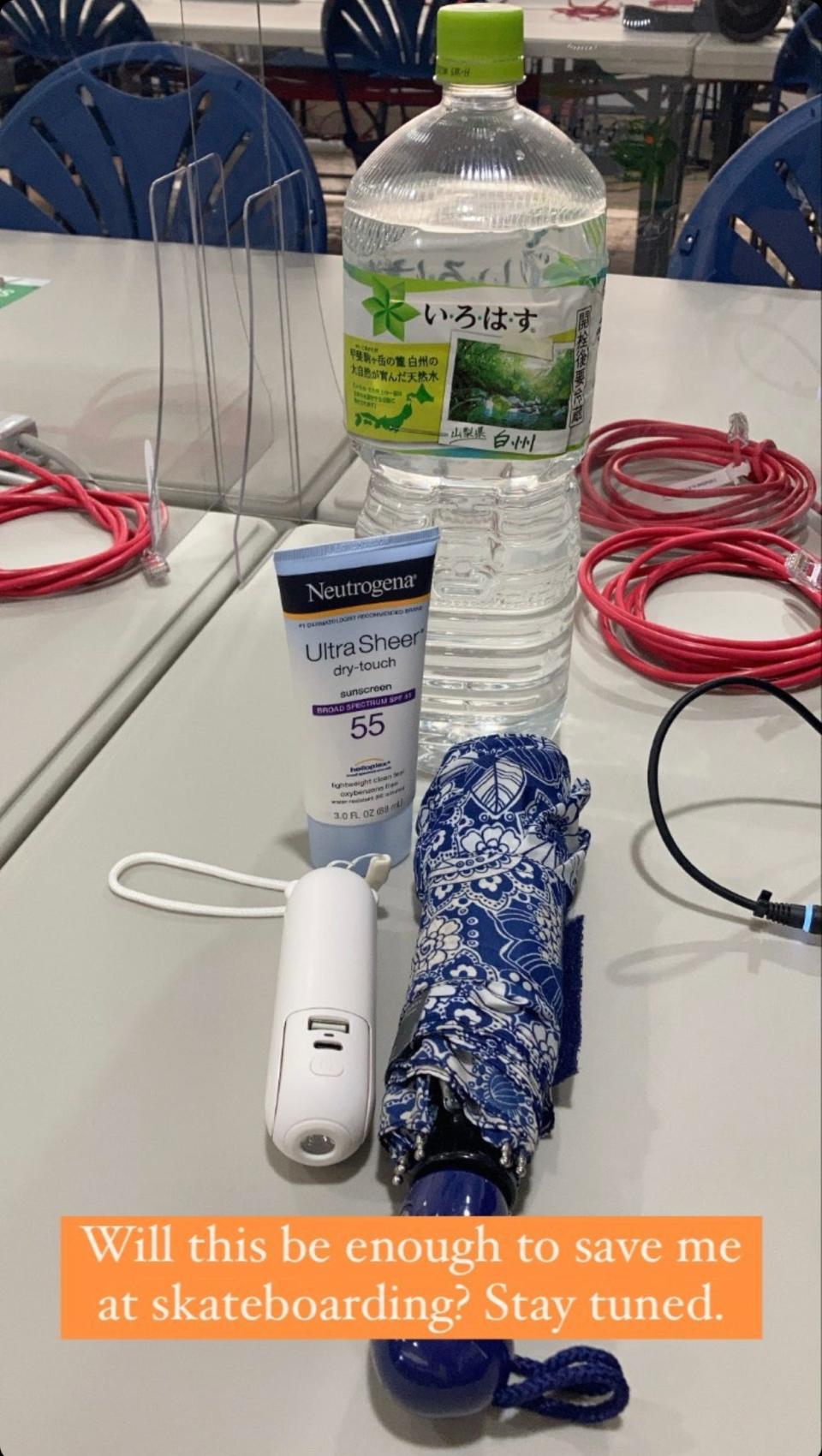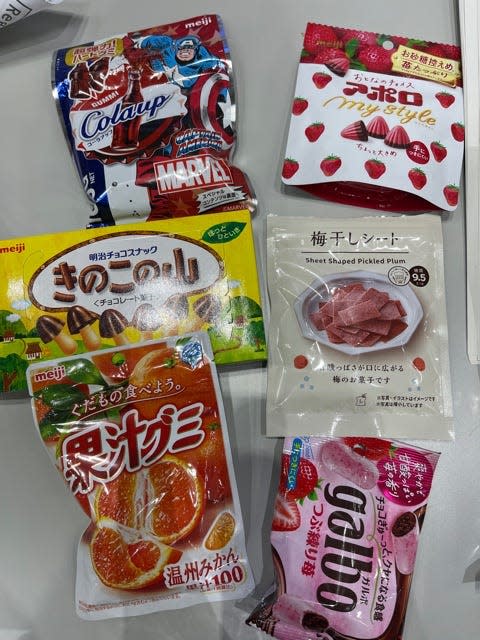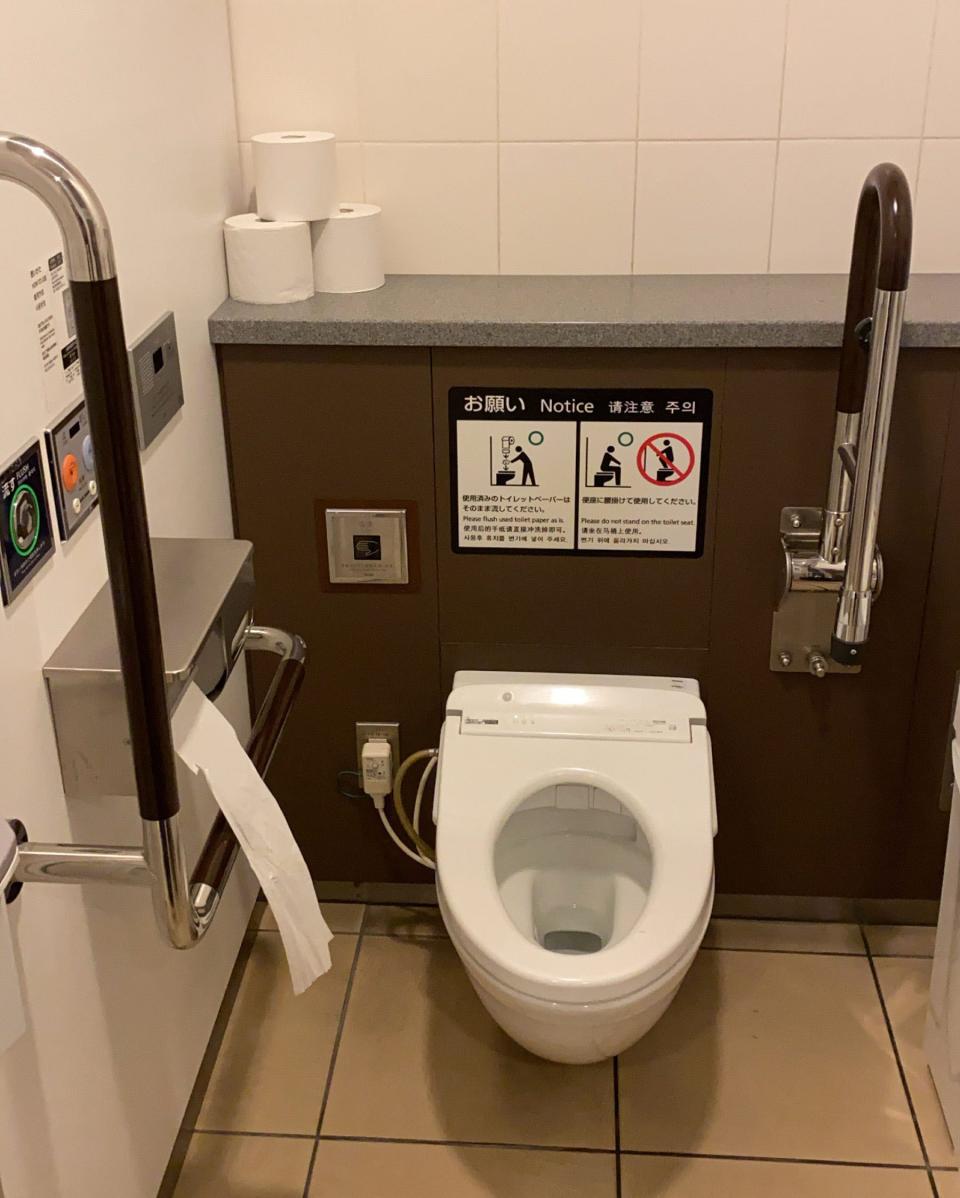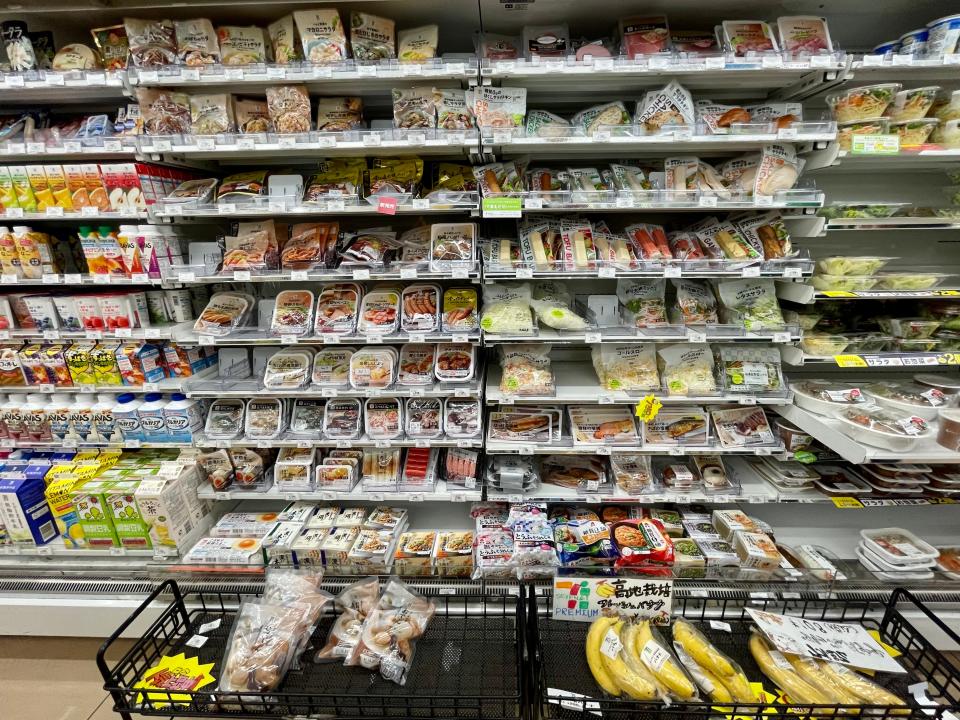Go behind the scenes at the Tokyo Olympics with USA TODAY journalists
TOKYO — Between bus rides, temperature checks, hand sanitizer stations and some news-gathering, the team of 36 journalists and technicians covering the Tokyo Olympics for USA TODAY is getting a chance to experience some Japanese culture and customs, inside the bubble(ish) atmosphere. We wanted to share some of the shocking, surprising and delightful things we've encountered.
You can also read about and watch more of our experiences on our personal social accounts. Follow all the USA TODAY journalists covering the Tokyo Games on Twitter and follow this hashtag #USATokyoPhoto on Instagram for stunning photos from our visual journalists. If you're interested in texting with us while we're covering the Olympics, subscribe here.
Oh, and keep checking back here for more behind-the-scenes updates throughout the Games.
Gotta get those steps in
How do you exercise at the Olympics? Well, if you’re anyone but an athlete here, it’s difficult.

Sure, there’s the constant work and prioritizing sleep. But during these pandemic Games, restrictions to prevent the spread of coronavirus have made it all but impossible.
During our first 14 days in Japan, we are not allowed outside of our Olympic bubble – the hotel, main press center and approved venues. That means not walking outside, and, critically for me, no running.
I like to run half-marathons and marathons, but more than that, I’m one of those people who needs running for my sanity. So, for two weeks without it, I’m improvising.
The MPC’s endless escalators have basically become hill repeats. (The coach of my running team in very flat Florida would be quite proud given my disdain for them normally.)
Just to get from our USA TODAY offices to a press conference with Tokyo organizers, I go up and down 11 floors on escalators, including one that spans four floors. Want to get your heart rate up? Walk that.
I have discovered, belatedly, that this is discouraged. But combine it with some resistance bands and workout videos I can do in my hotel room, and I might get through the first two weeks. Once day 15 gets here and I can lace up my running shoes again, I’ll resume standing on the endless escalators like a normal person.
– Rachel Axon, @RachelAxon on Twitter
Preparing for all the elements at outdoor events

The laptop, notepad, pen and audio recorders are all standard equipment. I couldn’t cover an event without them.
But covering skateboarding during these Games added to my list. A giant bottle of water, 55 SPF sunscreen, an umbrella and a handheld fan became essentials. Wearing breathable fabrics was imperative.
It’s summer here in Tokyo, and, in case you hadn’t seen Olympians sweating buckets, I can confirm it is hot. Checking my watch from the press tribune during the women’s street competition on Monday, I didn’t see it below 94 degrees.
Near the end of the final, I moved to sit on the stairs since the press tribune offered better shade. In the mixed zone, where we interview athletes after they compete, tents mercifully kept us out of the sun – save for my legs, which I had slathered in sunscreen. And my handheld fan (which looks like a bear!) kept me from sweating through my face mask.
Did I sweat the whole time? Yes, definitely. That’s where the water saved the day with more than 2 liters down since I got off the bus.
So, yeah, covering events in the extreme heat brings its challenges, but none we can’t handle with a little preparation.
And with all that in my bag, I needed one more thing to weather the conditions – a jacket. The air conditioning indoors is doing all it can to keep up with this heat.
– Rachel Axon, @RachelAxon on Twitter
Quite pleased with the security here so far
On my fourth full day at my 15th Olympics, I was struck by the realization that this organizing committee has security down pat.
As opposed to pat down or worse from other Games since 9/11 (not that I will ever truly be angry over an attempt to protect me and others).

But there are no long lines here for mag and bag. It takes a brisk five minutes max to get through to the Main Press Center or an event venue, at least in my experience to date. The worst you can say about it is that each entry includes a mandatory spray of hand sanitizer and really in a COVID world who is going to make a fuss over that?
Having facial recognition linked to your credential helps to speed the process along and after a speedy bag search even military personnel say thanks and are friendly rather than intimidating.
I remember thinking late in the 2000 Sydney Olympics that security had become a bit too lax from the Aussies no-worries mindset. Then 9/11 happened, and security everywhere changed.
The Japanese, admittedly without spectators to screen, seem to have struck the right tone with security and organizationally are functioning at peak Olympic form from the outset.
I certainly don’t need an escort every morning from my hotel to a bus stop one-and-a-half blocks away, but that appears to be a COVID precaution – aka don’t go where you’re not supposed to go. And the young man required to perform that job countless times in the heat is so well meaning that I gave him one of my Olympic USA TODAY Sports pins for his effort.
Writing all this probably means something will happen to throw security into a tizzy soon. But for now, the Japanese get gold for their efficient yet unimposing security.
– Jeff Metcalfe, @jeffmetcalfe on Twitter
The convenience store is where it's at

Among the 40 or so countries I’ve visited, nobody does packaged snacks as comprehensively, creatively or ubiquitously as Japan. They’re absolutely everywhere – sweet or savory, salty or spicy, pickled or sugared, crispy or gummied. Any flavor you can possibly think of, you’ll find it in a Japanese convenience store.
But for those of us who can’t read the language, good luck trying to figure out what you’re buying – until you open the package. Though some of the snacks offer pretty strong context clues – a pouch with a picture of a juicy orange indeed yielded orange-shaped and flavored gummies.
On my first trip through the convenience store at the Main Press Center in Tokyo, I played it pretty safe and bought a bunch of different kinds of sweets. I was able to identify a couple of different kinds of candies with strawberry and chocolate, some cola-flavored gummies and some strips of dried plum. The only thing I wasn’t sure about was a yellow box with pictures of mushrooms, which were actually chocolate molds on top of cookie sticks that were only made to look like mushrooms. All of them were pretty tasty except the plums, which were a bit on the salty side.
As the Olympics go on, I’ll have to get a little more adventurous with the savory snacks, which are going to be a bit harder to identify just by the labeling. But one thing is clear: When it comes to stuffing artificial flavors into bite-sized packages, your options in this country are almost unlimited.
– Dan Wolken, @DanWolken on Twitter
The bathrooms here are amazing

After a few hours of COVID-19 testing and immigration and customs checks, I grabbed my luggage and started to head out of Haneda Airport in Tokyo. I remembered one of my coworkers texted in our group chat that getting to the hotel was a bus ride, then a taxi ride, and I made an abrupt U-turn to stop by the bathroom.
My oh my was that a good idea! The bathrooms are spectacular in Japan.
There were so many buttons, switches, signs and levers, that I was afraid to touch anything. As I moved closer to the toilet, the sound of running water started to play through a speaker on the wall. I thought the sound was supposed to help make you go, but a few Twitter followers let me know it's to help mask any sounds you might make 😳 .
Yes, there are bidets on every toilet I've used – a question many people have asked. But there are also dials to change the temperature of the water and the water pressure, a button to warm the toilet seat, a toilet cleaner dispenser that I may have thought was hand sanitizer (oops) and a touch-less sensor you hold your hand in front of to flush.
Tokyo bathrooms: 10/10 would recommend.
- Alex Ptachick, @alexptachick on Twitter
I'm TikTokyo-ing my way through my first Olympics
It’s my first Olympics, and part of my official “duties” is to film everything.
The TikTok-ing (TikTokyo-ing?) actually began a few days before my flight. We previewed the new Olympic sports and posted something “on trend” (a new TikTok term I learned) about why the Olympics, happening in 2021, are still referred to as Tokyo 2020.
The original sound I wanted was “Jackie Chan” by Post/Tiesto but alas this is just a ~little~ of my journey to Japan. Day 2 on the ground starts now! pic.twitter.com/CnXoLqiMzS
— Chris Bumbaca (@BOOMbaca) July 21, 2021
I had my phone camera rolling for much of my travels here – which lasted a good 28 hours total, thanks to the Narita Airport taking five hours to process my flight’s COVID-19 test results. But the content – content over everything – turned out fine, even if I couldn’t use the original sound I wanted.
If you’re not catching my drift by this point, I’m begging you to follow @usatoday on TikTok. We’ve got some awesome athlete takeovers on the account, too, so it’s not just my face. And let us know what you want to see!
- Chris Bumbaca, @BOOMbaca on Twitter
NEVER MISS A MEDAL: Sign up for our Olympic newsletter now
WANT BEHIND-THE-SCENES ACCESS IN TOKYO? Sign up for Olympic texts to get exclusive access to the Games
A menace on the Japanese staircases

It didn’t hit me until the fifth day here. You drive on the left in Japan, much like other parts of the world. Ergo, general guidance and logic would dictate “stay to your left.”
My brain couldn’t comprehend that until Saturday. I was covering swimming prelims at the Tokyo Aquatics Centre. (I would write other things about the organization of the venue — which is beautiful, and it’s a shame it can’t be packed to the gills — but they are not appropriate to print.)
There I was, barreling down the staircase, moving past the people also descending. I was heading right into oncoming foot traffic, not the first time I’ve done that thinking, “What is everyone doing?!”
Then I saw the sign, literally. Arrow pointing to the left. What equates to a “no” sign to the right.
Call me the Derek Zoolander of stairs — I can’t go left.
I’ll do my best to break what is natural to me. Good thing I won’t be behind the wheel of a vehicle here (I hope).
- Chris Bumbaca, @BOOMbaca on Twitter
A piece of folded paper art that brings a smile to your face every time

After a very long day of travel to Tokyo, I was simply delirious, but also starving. Because Japan is under a state of emergency, we're not allowed to freely move about the city until after 14 days pass. So the only food option I knew of late at night, was UberEats. I ordered some (freaking fantastic!) sushi.
When the delivery driver arrived, he gave me my meal and then handed me an origami that said "Welcome to Japan." It was such a sweet gesture and it really did make me feel welcomed in a country I had never visited before.
The next day, I was chatting with a couple of Olympics-affiliated people working an information desk. As we finished our conversation and I thanked them for helping me, I started to walk away. One woman stopped me and insisted I take one of her pieces of origami. Again, this woman helped me get some information I needed, but then also wanted to give me a gift. I accepted the origami and felt the same gratitude I experienced the night before. There's something special about these unique pieces of folded paper.
- Alex Ptachick, @alexptachick on Twitter
I'm in 7-Eleven heaven
It’d been almost 24 hours since my flight out of San Francisco International Airport landed here, since I’d navigated a maze of COVID-related checkpoints at Narita International Airport and had arrived by taxi at my hotel, with pressing business at hand.
Find food – I was starving.
Mere steps outside my hotel, the distinctive green sign accented with red, orange and white beckoned – 7-Eleven.
There are sights that help define Tokyo – the immaculate streets, the breathtaking bay and the 7-Elevens on nearly every street. I’ve begun to count them, but it’ll take more than an Olympian effort.
There are more than 20,000 of the 24-hour convenience stores in Japan, which has more 7-Elevens than any other country in the world. Even more than we have, America.
Wonderfully, one of those stores is located mere steps from the hotel where I’m staying.

It provided nourishment after my journey here, late-night snacks since and at about 8 a.m. Saturday, yet another trip to the store, where I joined the steady traffic of customers and enjoyed the cultural juxtaposition.
Inside, I’m greeted by the familiar cases of hot food – corn dogs, spicy fried chicken and French fries. But, there also is chicken skin with soy sauce, chicken meatballs with soy sauce and the salty minced beef culet.
Dare I try one of those options? Not yet.
As I head deeper into the store, it’s deeper into unfamiliar territory. Cases of refrigerated food that include boiled octopus, cheese mousse and blueberry sauce and stewed tofu and Hijiki seaweed.
My top recommendation: The breaded pork sandwich on white bread, sans crust.
But, there’s been a downer: no Slurpees.
They haven’t been available at the 7-Elevens here since the 1980s, when the Japanese decided the iced drinks were passe, according to an Associated Press report.
But on Saturday morning, even without the site of cherry Slurpees, I still felt at home as I explored the options of Japanese food and over the store speakers heard the theme music of “SpongeBob SquarePants."
– Josh Peter, @joshlpeter11 on Twitter
Olympic pin trading is my thing

I’ve interviewed dozens of hardcore Olympic pin traders at the Games since my first in 2014. It’s a fascinating subculture. To sum it up, National Olympic Committees, media outlets and sponsors design metal pins featuring imagery unique to the Olympics and the host country. These pins are then traded between parties and displayed on their credential lanyards (only the ones you’re willing to give up though – that’s pin etiquette). It's also a nice gesture to give a pin away as a "thank you," during your Olympic journey, even if you don't get one in return.
Pin collectors travel from Games to Games showing off their rich collections spanning decades. They wait outside venues to trade with Olympic officials, media and other pin traders. That’s all missing this year because Tokyo is under a state of emergency, so no international spectators are allowed to travel to watch the Games in person, let alone pin trade.
Instead, we the media, are left to roam the halls of the Media Press Center and poke our heads into various offices asking if they have pins to trade. Some, like our friends at The Washington Post, didn’t bring pins to trade because of COVID protocols. Others, such as Getty Images and The New York Times, got creative and used the year delay or social distancing in their designs.
It might be a little harder to find pins to trade this year, but I’m willing to hunt.
– Sandy Hooper, @sandyhooper on Twitter
This article originally appeared on USA TODAY: Tokyo Olympics: Stories from reporters behind the scenes

